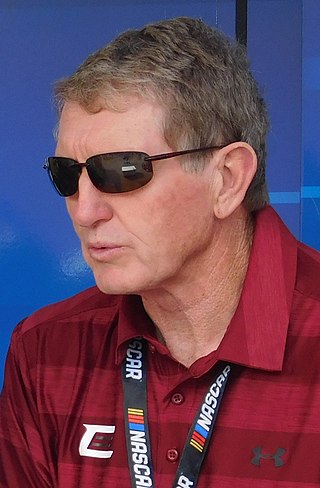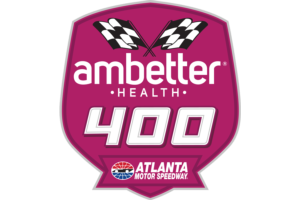
Ralph Dale Earnhardt was an American professional stock car driver and racing team owner, who raced from 1975 to 2001 in the former NASCAR Winston Cup Series, most notably driving the No. 3 Chevrolet for Richard Childress Racing. His aggressive driving style earned him the nicknames "the Intimidator", "the Man in Black" and "Ironhead"; after his son Dale Earnhardt Jr. joined the Cup Series circuit in 1999, Earnhardt was generally known by the retronyms Dale Earnhardt Sr. and Dale Sr. He is regarded as one of the greatest drivers in NASCAR history and named as one of the NASCAR's 50 Greatest Drivers class in 1998.

Ralph Dale Earnhardt Jr. is an American professional stock car racing driver, team owner, and broadcaster. A third-generation driver, he is the son of the late 7-time NASCAR Cup Series champion Dale Earnhardt and relative to many former and current drivers in the NASCAR ranks. Since retiring from full-time competition after the 2017 season, he has competed part-time in the NASCAR Xfinity Series, driving the No. 88 Chevrolet Camaro for his team, JR Motorsports.

David Carl Allison was an American NASCAR driver. He was best known for driving the No. 28 Texaco-Havoline Ford for Robert Yates Racing in the NASCAR Cup Series. Born in Hollywood, Florida, he was the oldest of four children born to Bobby and Judy Allison. The family moved to Hueytown, Alabama, and along with Bobby Allison's brother, Donnie, Red Farmer and Neil Bonnett, became known as the Alabama Gang.

Russell William "Rusty" Wallace Jr. is an American former NASCAR racing driver. He won the 1984 NASCAR Cup series Rookie of the Year and the 1989 NASCAR Winston Cup Championship. For the accolades over the course of his successful career, Wallace has been inducted in the NASCAR Hall of Fame (2013), the International Motorsports Hall of Fame (2013), the Motorsports Hall of Fame of America (2014) and the National Motorsports Press Association Hall of Fame (2010).

William Clyde Elliott Sr., also known as "Awesome Bill from Dawsonville", "Million Dollar Bill", or "Wild Bill" is an American former professional stock car racing driver. He last competed in the Camping World Superstar Racing Experience part-time in 2022. His accolades include the 1988 Winston Cup Championship and garnering 44 wins in that series, including two Daytona 500 victories in 1985 and 1987, three Southern 500 victories in 1985, 1988, and 1994, one Winston 500 victory in 1985, one Brickyard 400 victory in 2002, one "The Winston All-Star Race" win in 1986, and a record four consecutive wins at Michigan International Speedway between 1985 and 1986.

Alan Dennis Kulwicki, nicknamed "Special K" and the "Polish Prince", was an American auto racing driver and team owner. He started racing at local short tracks in Wisconsin before moving up to regional stock car touring series. Kulwicki arrived at NASCAR, the highest and most expensive level of stock car racing in the United States, with no sponsor, a limited budget and only a racecar and a borrowed pickup truck. Despite starting with meager equipment and finances, he earned the 1986 NASCAR Rookie of the Year award over drivers racing for well-funded teams.

The Ambetter Health 400 is a NASCAR Cup Series stock car race held at Atlanta Motor Speedway in Hampton, Georgia. Daniel Suárez is the defending race winner.
The 1990 NASCAR Winston Cup Series was the 42nd season of professional stock car racing in the United States and the 19th modern-era Cup Series. It began on Sunday, February 11, and ended on Sunday, November 18. Because of a highly controversial penalty to Mark Martin early in the season, Dale Earnhardt with Richard Childress Racing was crowned the Winston Cup champion for the fourth time, edging out Martin by 26 points.

The 1993 NASCAR Winston Cup Series was the 45th season of professional stock car racing in the United States and the 22nd modern-era Cup season. The season began on February 7 and ended on November 14. Dale Earnhardt of Richard Childress Racing won the title, the sixth of his career.

The 1992 NASCAR Winston Cup Series was the 44th season of professional stock car racing in the United States and the 21st modern-era Cup season. The season began on February 9, 1992, and ended on November 15, 1992. Independent owner/driver Alan Kulwicki of AK Racing won the Winston Cup championship.

The 1991 NASCAR Winston Cup Series was the 43rd of professional stock car racing in the United States and the 20th modern-era Cup Season. It began February 10 and ended November 17. Dale Earnhardt of Richard Childress Racing won his fifth Winston Cup championship at the conclusion of the season. The season was marred by the death of driver and team owner J. D. McDuffie, who was killed in a wreck at Watkins Glen.
The 1989 NASCAR Winston Cup Series was the 41st season of professional stock car racing in the United States and the 18th modern-era Cup season. It began February 12 and ended November 19. Rusty Wallace of Blue Max Racing won the championship. This was the first year that every Winston Cup race had flag to flag coverage, with almost all of them being televised live.

The 1988 NASCAR Winston Cup Series was the 40th season of professional stock car racing in the United States and the 17th modern-era Cup series. The season began on February 7 at Daytona International Speedway and ended on November 20 at the Atlanta International Speedway. Bill Elliott of Melling Racing won the championship.

The 1987 NASCAR Winston Cup Series was the 39th season of professional stock car racing in the United States and the 16th modern-era cup series.
The 1986 NASCAR Winston Cup Series was the 38th season of professional stock car racing in the United States and the 15th modern-era Cup series season. The season began on February 16 and ended November 16. Dale Earnhardt of RCR Enterprises won his second championship this year.

The 1992 Hooters 500 was the 29th and final race of the 1992 NASCAR season. It was held on November 15, 1992, at Atlanta Motor Speedway and is widely considered the greatest NASCAR race of all time, with three stories dominating the race: the debut of Jeff Gordon in the Winston Cup Series, the final race of seven-time champion Richard Petty's thirty-five-year career, and the battle for the series points championship with six drivers mathematically eligible to win the title.

Tony Gibson is a retired American auto racing crew chief. He last worked for the #41 Stewart-Haas Racing Ford driven by Kurt Busch in the NASCAR Monster Energy NASCAR Cup Series. He was the crew chief for Busch's 2017 Daytona 500 victory. Gibson worked as car chief on Alan Kulwicki’s title team of 1992 and was also the car chief on Jeff Gordon’s title teams of 1998 and 2001. With Dale Earnhardt Incorporated, Gibson, was the crew chief for racers such as Steve Park, Michael Waltrip, Dale Earnhardt Jr., Mark Martin and at Stewart-Haas Racing for Ryan Newman from 2009 to the majority of 2012 and Danica Patrick for 2013 to most of 2014 before swapping drivers.
This article documents historical records, statistics, and race recaps of the Daytona 500, held annually at Daytona International Speedway in Daytona Beach, Florida.

The 1999 Coca-Cola 600, the 40th running of the event, was a NASCAR Winston Cup Series race held on May 30, 1999 at Lowe's Motor Speedway in Concord, North Carolina. Contested at 400 laps on the 1.5 mile speedway, it was the twelfth race of the 1999 NASCAR Winston Cup Series season.
The NASCAR Winston Cup Series era was the period of the National Association for Stock Car Auto Racing (NASCAR) from 1971 to 2003. In 1971, NASCAR leased its naming rights to the R.J. Reynolds Tobacco Company who named the series after its premier brand "Winston". The series was referred to as the NASCAR Winston Cup Series from that point forward. Many view the changes that resulted from RJR's involvement in the series as well as from the reduction in schedule from 48 to 31 races per year established 1972 as a time in which NASCAR entered the "modern era" of spectator sports. During this era, NASCAR experienced a significant rise in popularity that persisted until Winston left the sport after the 2003 season.













